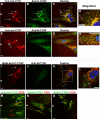TGF-β-stimulated CTGF production enhanced by collagen and associated with biogenesis of a novel 31-kDa CTGF form in human corneal fibroblasts
- PMID: 20393108
- PMCID: PMC3066619
- DOI: 10.1167/iovs.09-5110
TGF-β-stimulated CTGF production enhanced by collagen and associated with biogenesis of a novel 31-kDa CTGF form in human corneal fibroblasts
Abstract
Purpose: Connective tissue growth factor (CTGF) is induced by transforming growth factor-beta (TGF-β) after corneal wounding. This study addressed the role of the extracellular matrix in the induction of CTGF by TGF-β.
Methods: Human corneal fibroblasts (HCFs) were grown on fibronectin (FN), vitronectin (VN), or collagen (CL) in supplemented serum-free media alone or with TGF-β1 or fibroblast growth factor plus heparin. CTGF mRNA was analyzed by qPCR and protein expression by Western blot analysis of Triton X-100 (TX-100)-soluble and TX-100-insoluble cell lysates using antibodies to N-terminal, mid, and C-terminal CTGF regions. Immunocytochemistry was performed on nonconfluent or scrape-wounded confluent HCFs.
Results: TGF-β-treated HCFs grown on CL produced five times more 38-kDa CTGF than untreated controls (72 hours). TGF-β-treated HCFs on CL secreted twofold more CTGF than those on FN or VN. Furthermore, a 31-kDa CTGF form, lacking the N-terminal domain, was detected in Triton X-100 insoluble fractions in Western blot analysis. Immunodetectable extracellular CTGF formed linear arrays parallel to, but not colocalized with, CL or FN. It also did not colocalize with FAK, vinculin, or integrins α(v)β(3) and α(5)β(1). Intracellular CTGF was detected in the Golgi apparatus and vesicles, including endosomes.
Conclusions: Enhanced CTGF secretion induced by TGF-β in CL-grown cells may contribute to positive feedback in which CL is overexpressed in CTGF-induced fibrosis. N-terminal CTGF fragments in the plasma of patients with severe fibrotic disease may be a product of CTGF proteolysis that also produces the newly identified 31-kDa CTGF that remains cell associated and may have its impact by non-integrin signaling pathways.
Figures







Similar articles
-
Transforming growth factor-beta-stimulated connective tissue growth factor expression during corneal myofibroblast differentiation.Invest Ophthalmol Vis Sci. 2001 Oct;42(11):2534-41. Invest Ophthalmol Vis Sci. 2001. PMID: 11581194
-
Connective tissue growth factor expression and action in human corneal fibroblast cultures and rat corneas after photorefractive keratectomy.Invest Ophthalmol Vis Sci. 2003 May;44(5):1879-87. doi: 10.1167/iovs.02-0860. Invest Ophthalmol Vis Sci. 2003. PMID: 12714619
-
Effects of enamel matrix derivative and transforming growth factor-β1 on connective tissue growth factor in human periodontal ligament fibroblasts.J Periodontol. 2015 Apr;86(4):569-77. doi: 10.1902/jop.2015.120448. Epub 2015 Jan 16. J Periodontol. 2015. PMID: 25594423
-
[Connective tissue growth factor synergistically with transforming growth factor beta 1 to promote renal fibrosis].Zhonghua Yi Xue Za Zhi. 2004 Apr 2;84(7):569-73. Zhonghua Yi Xue Za Zhi. 2004. PMID: 15144592 Chinese.
-
Corneal fibroblast collagen type IV negative feedback modulation of TGF beta: A fibrosis modulating system likely active in other organs.Matrix Biol. 2022 May;109:162-172. doi: 10.1016/j.matbio.2022.04.002. Epub 2022 Apr 11. Matrix Biol. 2022. PMID: 35421526 Review.
Cited by
-
GLUT10 deficiency leads to oxidative stress and non-canonical αvβ3 integrin-mediated TGFβ signalling associated with extracellular matrix disarray in arterial tortuosity syndrome skin fibroblasts.Hum Mol Genet. 2015 Dec 1;24(23):6769-87. doi: 10.1093/hmg/ddv382. Epub 2015 Sep 16. Hum Mol Genet. 2015. PMID: 26376865 Free PMC article.
-
Proteolytic processing of connective tissue growth factor in normal ocular tissues and during corneal wound healing.Invest Ophthalmol Vis Sci. 2012 Dec 13;53(13):8093-103. doi: 10.1167/iovs.12-10419. Invest Ophthalmol Vis Sci. 2012. PMID: 23139278 Free PMC article.
-
A connective tissue growth factor signaling receptor in corneal fibroblasts.Invest Ophthalmol Vis Sci. 2012 Jun 5;53(7):3387-94. doi: 10.1167/iovs.12-9425. Invest Ophthalmol Vis Sci. 2012. PMID: 22511630 Free PMC article.
-
Inhibitory effects of PPARγ ligands on TGF-β1-induced CTGF expression in cat corneal fibroblasts.Exp Eye Res. 2015 Sep;138:52-8. doi: 10.1016/j.exer.2015.06.028. Epub 2015 Jul 2. Exp Eye Res. 2015. PMID: 26142957 Free PMC article.
-
Mycobacterium tuberculosis induces connective tissue growth factor expression through the TLR2-JNK-AP-1 pathway in human lung fibroblasts.FASEB J. 2019 Nov;33(11):12554-12564. doi: 10.1096/fj.201900487R. Epub 2019 Aug 26. FASEB J. 2019. PMID: 31451010 Free PMC article.
References
-
- Blalock TD, Duncan MR, Varela JC, et al. Connective tissue growth factor expression and action in human corneal fibroblast cultures and rat corneas after photorefractive keratectomy. Invest Ophthalmol Vis Sci. 2003;44:1879–1887 - PubMed
-
- Secker GA, Shortt AJ, Sampson E, Schwarz QP, Schultz GS, Daniels JT. TGFβ stimulated re-epithelialisation is regulated by CTGF and Ras/MEK/ERK signalling. Exp Cell Res. 2008;314:131–142 - PubMed
-
- Grotendorst GR. Connective tissue growth factor: a mediator of TGF-β action on fibroblasts. Cytokine Growth Factor Rev. 1997;8:171–179 - PubMed
-
- Brigstock DR. The connective tissue growth factor/cysteine-rich 61/nephroblastoma overexpressed (CCN) family. Endocr Rev. 1999;20:189–206 - PubMed
-
- Gao R, Brigstock DR. Connective tissue growth factor (CCN2) induces adhesion of rat activated hepatic stellate cells by binding of its C-terminal domain to integrin alpha (v) beta(3) and heparan sulfate proteoglycan. J Biol Chem 2004;279:8848–8855 - PubMed
Publication types
MeSH terms
Substances
Grants and funding
LinkOut - more resources
Full Text Sources
Miscellaneous

